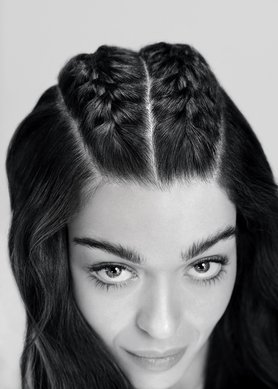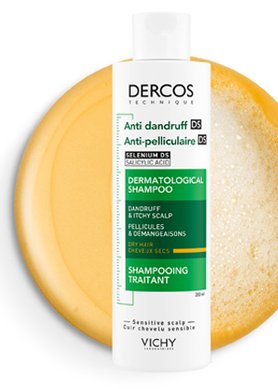
Navigating an oily scalp can be a frustrating process; hair can often feel unclean and look greasy – even hours after washing. If you find that your scalp and hair feel oily, it might be time to overhaul yourhair care habits and routine. However, it’s important to take care with oily hair treatments so you maintain a balanced scalp. In this expert guide, we’ve put together our top tips for how to treat your oily scalp and hair with the help of targeted products and a few lifestyle changes.
What causes an oily scalp?
When approaching oily scalp treatments, it’s important to understand what might be causing your oily scalp and hair. Genetics dictate the number of sebaceous glands in our skin, and the scalp is one the most concentrated areas for sebaceous glands on the entire body.1 These glands produce and secrete sebum – the body’s natural oils. The more sebum your scalp produces, the oilier your scalp and hair will be.
However, there are several other contributing factors that may be exacerbating the look and feel of your oily scalp and hair. Overall, the primary causes of an oily scalp can include:
· Genetics (as discussed above)
· Improper shampoos that remove the hair’s natural oils
· Repeatedly touching your hair
· Changes in weather like high humidity or pollution
· Dirty hair brushes and styling tools that transfer oil and product buildup
· Stress and hormonal changes that trigger overactive sebaceous glands
Some hair types are more affected by oil than others. For instance, an oily scalp and strands tend to be more noticeable on those with straight, fine hair because oil readily travels down the hair shaft. Oily scalp types might also be prone to oily hair and dandruff because dandruff flakes cling to sebum and collect on the scalp.
How to treat an oily scalp: 5 tips and strategies
Our best advice for oily scalp and hair treatment is to approach your hair care holistically:
1. Wash your hair with a shampoo that is specific to oily scalp types.
2. Consider how often you are washing your hair and adjust as needed.
3. Avoid touching your hair and exacerbating oil production.
4. Keep styling tools and pillowcases clean to prevent the spread of oil.
5. Strategically employ dry shampoo between wash days.
Read on as we explore these tips in depth.
Use a targeted shampoo
One of the most effective methods to tackle an oily scalp is to wash your hair with a shampoo formulated specifically for this scalp and hair concern. Some ingredients are more successful than others at regulating sebum production – salicylic acid is one such ingredient. Using salicylic acid for hair can help regulate excess sebum production and deeply cleanse the hair follicles.
Dercos Anti Dandruff DS Shampoo For Normal To Oily Hair utilises salicylic acid as one of its primary ingredients to target excess sebum and a disrupted microbiome. Use this shampoo three times per week for four weeks, before reducing to once per week. This is a potent shampoo designed for both oil control and dandruff, so you can alternate washes with the Dercos Mineral Soft - Soft and Fortifying Shampoo – a purifying shampoo that strengthens and softens the hair.
Adjust your washing schedule
Before we delve into your shampoo habits, we want to squash a misconception about one infamous oily hair remedy: you cannot train your hair to produce less oil by washing it less. As we have established, the number of sebaceous glands on your scalp is dictated by genetics. However, it is possible that you might be intensifying oil production by over or under-washing your hair.
When we over-wash the hair, particularly with the wrong type of shampoo, it can rob the scalp of natural oils. This triggers the scalp to produce excess oil to compensate for that loss. Conversely, not washing the hair enough can lead to a buildup of oil, dirt, sweat and hair product (such as dry shampoo and hairspray). To avoid disrupting your natural oil levels, try washing your hair every 2-3 days.
Avoid touching your hair
Playing with your hair is second nature to most people, but the oil and bacteria from your hands can transfer to your hair and scalp – exacerbating your oil concerns. To bolster the work of your oily hair treatment, do what you can to avoid touching your hair, whether that means embracing more updos and loose braided styles or occupying your hands with a stress ball.
Keep your pillowcases and styling tools clean
Pillow cases and hair care and styling tools can harbour oil, dirt, product and other debris that can transfer to your scalp and hair. So, one of our top recommendations for an oily scalp treatment is to ensure you are frequently cleaning the tools that come into regular contact with your hair. This includes:
· Brushes and combs – make sure to remove hair buildup and wash them weekly using a gentle shampoo.
· Heat styling tools – once cooled, use a damp cloth or makeup wipe to clean the hot plates on your hair straightener and curling wand every few weeks.
· Pillowcases – bedding not only absorbs oil from your scalp, but skincare products and sweat as well. We suggest washing once per week.
Embrace dry shampoo
If you are someone who struggles to stretch out your hair between washes, dry shampoo can offer a temporary oily hair remedy to refresh the look of your roots. Dry shampoos are available in a range of different formulations including sprays, powders and mousses. They can also boost volume – which is a blessing for flat, oily hair. Ensure that you don’t rely on dry shampoo in place of washing to avoid product buildup on the scalp.
Choose the type of dry shampoo that is right for you and apply to oily sections of hair, holding the dry shampoo about 30 centimetres from your scalp to prevent noticeable product residue. Let it sit for a moment, then gently massage and distribute the product. Brush or comb the hair as needed.







